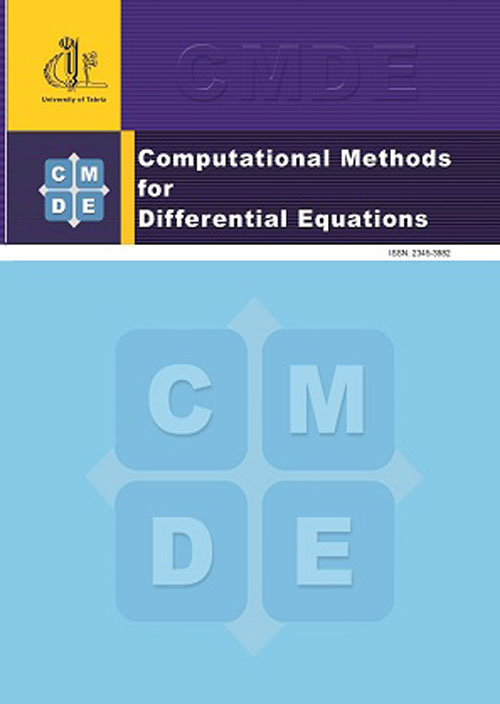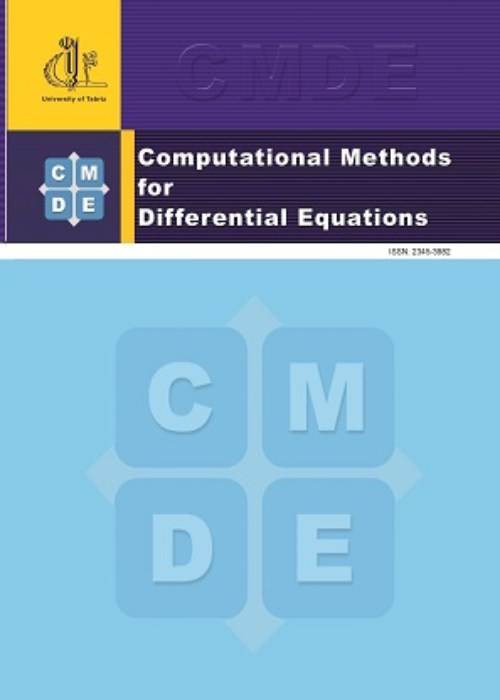فهرست مطالب

Computational Methods for Differential Equations
Volume:8 Issue: 4, Autumn 2020
- تاریخ انتشار: 1399/09/05
- تعداد عناوین: 15
-
-
Pages 610-638The present study applies the Picard iterative method to nonlinear singular partial fractional differential equations. The Haar and second-kind Chebyshev wavelets operational matrix of fractional integration will be used to solve problems combining linearization technique with the Picard method. The singular problem will be converted to an algebraic system of equations, which can be easily solved. Numerical examples are provided to illustrate the efficiency and accuracy of the technique.Keywords: Fractional singular differential equation, Haar wavelets, Second-kind Chebyshev wavelets, Picard iteration
-
Pages 639-647In this paper, we apply new type monotone iterative technique which is very rarely used to find iterative solutions for boundary value problem (BVPs) of nonlinear fractional order differential equations (NFODEs). With the help of the aforesaid technique, we establish two sequences of upper and lower solutions for the considered BVP. Further the procedure is testified by providing suitable examples.Keywords: Arbitrary order derivative, Monotone iterative technique, Boundary value problems
-
Pages 648-660In this paper, we find an integral representation for the fundamental solution of the fractional Ostrovsky equation in terms of the Airy and Bessel-Wright functions. The equation is studied in the sense of the Weyl fractional derivative and the solution is presented as the Airy transforms of Wright functions. Using the asymptotic expansion of Wright function the asymptotic behavior of solution is also discussed.Keywords: Fractional Ostrovsky equation, Wright function, Airy function, Asymptotic behavior
-
Pages 661-672Many quick-link optimization models of transferring corrosive materials, need some constraints to change the output space such that all of the criteria are met, which forms a nonlinear problem with specific constraints. So we use an approach for finding global solutions of mixed-integer nonlinear optimization problems with ordinary differential equation constraints on the shortest path problem connective body composition because we need to save time. For the solution of constrained differential equations, we present a numerical method by coupling an implicit numerical method, and the results will be expressed by showing that the optimal path is selected.Keywords: Implicit method, Shortest path, Constrained differential equations
-
Pages 673-684
In this work, we propose an efficient numerical algorithm based upon compact finite difference to solve Lane-Emden equations which are nonlinear ordinary differential equations. The presented method reduces the solution of Lane-Emden equations to the solution of a nonlinear system of equations. The numerical experiments show the accuracy and efficiency of this method.
Keywords: Lane-Emden equation, singular IVPs, Compact finite difference -
Pages 685-707
One of the schemes to find the optimal shape parameter and optimal number of points in the radial basis function (RBF) methods is to apply the stochastic arithmetic (SA) in place of the common floating-point arithmetic (FPA). The main purpose of this work is to introduce a reliable approach based on this new arithmetic to compute the local optimal shape parameter and number of points in multiquadric and Gaussian RBF-meshless methods for solving differential equations, in the iterative process. To this end, the CESTAC method is applied. Also, in order to implement the proposed algorithms, the CADNA library is performed. The examples illustrate the efficiency and importance of using this library to validate the results.
Keywords: Stochastic Arithmetic, CESTAC method, CADNA library, Differential equation, Radial basis function (RBF) -
Pages 708-732In this paper we investigate in detail the applications of the classical Newton-Raphson method in connection with a space-time finite element discretization scheme for the inviscid Burgers equation in one dimensional space. The underlying discretization method is the so-called streamline diffusion method, which combines good stability properties with high accuracy. The coupled nonlinear algebraic equations thus obtained in each space-time slab are solved by the generalized Newton-Raphson method. Exploiting the band-structured properties of the Jacobian matrix, two different algorithms based on the Newton-Raphson linearization are proposed. In a series of examples, we show that in each time-step a quadratic convergence order is attained when the Newton-Raphson procedure applied to the corresponding system of nonlinear equations.Keywords: finite element method, Burgers equation, Newton-Raphson method
-
Pages 733-744In this paper, the nonlinear system of initial value problems are solved numerically by using Residual method which is based on the minimizing residual function by the Taylor’s series expansion. The convergence analysis of the method is given. The significant feature of the method is reduction of nonlinear system of initial value problems to the system of linear equations. To emphasize the accuracy and potential of the method, we solve Lorenz system and primary HIV-1 infection problem numericallyKeywords: Nonlinear initial value systems, Bernstein polynomials, Residual method, Lorenz system, primary HIV-1 infection problem
-
Pages 745-761In this paper, stabilization of unstable fractional descriptor discrete-time linear system via forward and propositional output feedback is done to obtain satisfactory responses. To gain forward and propositional output feedback matrices, two standard linear systems need to exist. Assigning nonzero arbitrary eigenvalues to the first standard system and inverted the desired eigenvalues for standard descriptor system to the second one, desired eigenvalues are assigned by matrix inverse eigenvalue problem. Numerical examples are also presented to illustrate our method.Keywords: Fractional descriptor, Matrix inverse eigenvalue problem, Discrete-time, Output feedback, Moore-Penrose inverse
-
Pages 762-769In this research, we introduce an approach to find a family of sixth order SturmLiouville problems having the same spectrum. Using Darboux Lemma and the fact that any second order Sturm-Liouville problem with the Dirichlet boundary conditions is equivalent to a sixth order Sturm-Liouville problem, the considered problems are formulated.Keywords: Spectrum, eigenvalue, Equivalence relation, Darboux Lemma
-
Pages 770-780In this paper, optimal homotopy asymptotic method (OHAM) and multistage optimal homotopy asymptotic (MOHAM) method are applied to find an approximate solution to Abel’s integral equation, that is in fact a weakly singular Volterra integral equation. To illustrate these approaches one example is presented. The results confirm the efficiency and ability of these methods to such equations. The results will be compared with the exact solution to find out that which method of these two is more accurate.Keywords: Abel integral equation, weakly singular Volterra equations, Optimal Homotopy Asymptotic method, multistage optimal homotopy asymptotic method, series solutions
-
Pages 781-793The purpose of this paper is to present a numerical scheme for solving time-fractional partial differential equation based on cubic B-spline quasi-interpolation. For this purpose, first we will approximate the time-fractional derivative by Laplace transform method and then by using of cubic B-spline quasi-interpolation, the spatial derivatives are approximated. Moreover, the stability of this method is studied. Finally, European call and put options are priced and we will show that the results are good agreement with the other methods. The main advantage of the resulting scheme is that the algorithm is very simple, so it is very easy to implement.Keywords: time-fractional partial differential equation, Laplace transform, Quasi-interpolation, Fractional Black-Scholes equation
-
Pages 794-814In this paper we develop a non polynomial cubic spline functions which we called ”TS spline”, based on trigonometric functions. The convergence analysis of this spline is investigated in details. The definition of B-spline basis function for TS spline is extended and ”TS B-spline” is introduced. This paper attempts to develop collocation method based on this B-spline for the numerical solution of the nonlinear Klein-Gordon equation. The convergence analysis of this approach is discussed, the second order of convergence is proved consequently. The proposed method is applied on some test examples and the numerical results are compared with those already available in literature. Observed errors in the solutions show the efficiency and numerical applicability of the proposed method.Keywords: Non-polynomial spline function, B-spline function, Nonlinear Klein-Gordon equation, Convergence analysis
-
Pages 815-826In this paper, a denoising PDE model based on a combination of the isotropic diffusion and total variation models is presented. The new weighted model is able to be adaptive in each region in accordance with the image’s information. The model performs more diffusion in the flat regions of the image, and less diffusion in the edges of the image. The new model has more ability to restore the image in terms of peak signal to noise ratio and visual quality, compared with total variation, isotropic diffusion, and some well-known models. Experimental results show that the model is able to suppress the noise effectively while preserving texture features and edge information well.Keywords: Image Denoising, Isotropic Diffusion, Total Variation, Partial differential equation
-
Pages 827-839In the present work, we focus on solutions of K(p, p) equation which are solitons with compact support called compactons. Such a study of compact solitary waves will help us understanding solitons at a deeper level. One of the interesting feature, they govern is quasi elastic collision and gaining the same coherent shape again after scattering. Numerical scheme used to study the compacton solutions of K(p, p) equation is based on reduced differential transform method. Both one dimensional differential transform method and two dimensional reduced differential transform method have been used. Test problems under consideration show the efficient working of the proposed scheme.Keywords: Reduced Differential Transform Method, K(p, p) equation, Compacton


